’68 Chevelle FAST-QUICK-FIT TKX
Modern Driveline’s new TREMEC TKX Five-Speed
Offers the advantages of the proven TKO along with perfect fit
Click here to see the SEMA 2021 Interview with the car owner
Text & Photography by Jim Smart
TREMEC’s performance-proven TKO five-speed transmission became famous in the 1990s with the PRO 5.0 Mustang drag racing movement and has swiftly spread across all high-performance applications where higher torque capacity has been needed.
The TKO has always been a terrific high-torque box.
The issue has always been fitment and space in some applications.
Modern Driveline and TREMEC have listened to your concerns about fitment and have done something about it.
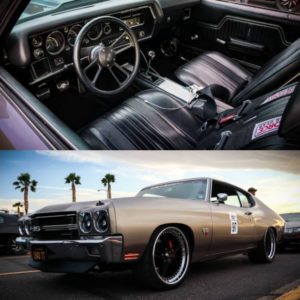
Modern Driveline has offered several great-fit TKO transmission conversion packages for specialized applications like the Sunbeam Tiger, Cobra, Corvette, and other tight-fit classic cars.
This made the TKO more do-able for more applications.
For the rest of us, there’s the new perfect fit TREMEC TKX from Modern Driveline engineered to fit a broad selection of classic performance cars without any modifications.
We’re working with Miguel Escamilla of M2 Performance who is performing a TKX swap on
James White’s 1968 Chevelle hardtop packing LS1 power, 4L60E transmission, and a 12-bolt rear end.
The LS1 is a stocker pulled from a total.
We’re going to remove the 4L60E and set this Bowtie ride up for the TKX.
This is a simple swap even though we’re going from an automatic overdrive to a five-speed stick.
Because James does a lot of autocross and road racing, he grew frustrated with the 4L60E and the absence of flexibility navigating a road course. It was also very hard on an automatic transmission, which with burning up clutches and bands along with ongoing maintenance costs.

All James needed was the flexibility of a stick and hydraulic clutch along with the fierce durability of a Modern Driveline (MDL) TKX.
James spoke with Bruce Couture of MDL who set him up with a complete TKX package along with a Kevlar/Organic clutch combo designed for both street and weekend competition.
Also included in the parcel was a hydraulic clutch kit, which takes the work out of clutching and shifting.
The MDL hydraulic clutch kit is an in-house engineered system proven on the track and street.
It beats the pants off your Chevy’s original bell-crank equalizer bar system, which requires a lot of effort.

The performance-proven TKO five-speed transmission (left) has a proven track record as a box that can take a hammering and come back for more.
The all-new TKX (right) sports the advantages of the TKO only with greater torque capacity, smooth shifts, roller bearings instead of bushings, and a compact design that fits in places the TKO cannot.

Removal of the 4L60E transmission involves the removal of the bellhousing bolts at the top of the bell first.
Though they can be accessed from underneath with an extension.

GM starters employ bolts that run through the case vertically into the engine block.
This is different than you will see with a Ford or Chrysler product where starter bolts go into the transmission’s bellhousing.
Did you remember to disconnect the battery?

This is the open bellhousing where the starter sits.
Once the starter is removed, you will need to hand-crank the engine to remove all of the torque converter bolts.
Above the arrow is the crank sensor.

Driveshaft removal is next.
With the X-pipe system James has on his Chevelle, it becomes necessary to drop the exhaust system enough to get the driveshaft out.
The good news is the Chevelle’s driveshaft, fabricated for the 4L60E, fits the TKX without modifications.

This is the GM 4L60E, which is the computer-controlled 700R4 void of a throttle valve cable.
The computer controls all shift events.

The 4L60E’s flexplate must be removed and replaced with the new Modern Driveline flywheel and clutch.

While the back of the engine is exposed, this is the best time to inspect the rear main seal for oil leakage.
In this case, we have an LS where the back cover is removable and the rear main seal is easy to replace.
The clutch pilot bushing has been installed (arrow).
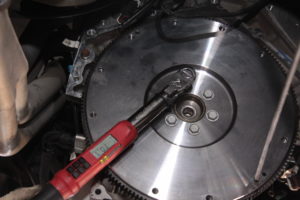
The flywheel has been seated and bolts installed. Always use a thread locker on bolt threads for security.
Torque these bolts crisscross to 74 ft/lbs in one-third values.
Snug the bolts first and confirm the flywheel is square with the crank flange, then, torque to specs.
The new clutch pilot bushing has been installed.

This is the Modern Driveline clutch with the Kevlar/Organic clutch disc for a sweet combination of street and strip performance.
Modern builds all its clutches in-house for strict quality control.
Each is custom-made to order.

Use thread locker on all bolts for added security and always torque bolts using a torque wrench to recommended specifications.

After you’ve applied a thread locker, torque the pressure plate bolts to 22 ft/lbs.
Make sure the clutch alignment tool is properly installed in the disc and pilot bushing before you tighten anything.
Torque in one-third values in a crisscross fashion.

The hydraulic clutch release alignment pin must always go in the 5 o’clock position as shown.
It must also be cut short enough that it will not interfere with the pressure plate.

Inner surfaces of the clutch release cylinder are lightly lubricated with high-temperature grease.
Too much grease and you will wind up with grease on clutch friction surfaces… Keep it very light.

The hydraulic clutch release cylinder is checked for fit and smooth function before the alignment pin is cut.
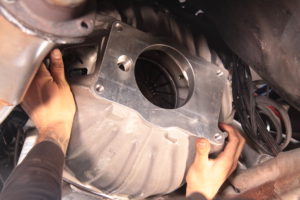
The MDL bellhousing is fit-checked, then, temporarily installed to confirm and adjust release cylinder-to-clutch finger depth.

The distance from the face of the transmission to the clutch diaphragm finger is measured here you’ll want to just touch the fingers. with no load pressure on them.
(see below for a definition of acceptable load)
The diaphragm clutch requires constant pressure, which makes the release bearing constant duty… It spins all the time.
The new generation of hydraulic throw-out bearings allows for constant contact of the throw-out bearing and is standard for hydraulic clutch actuation
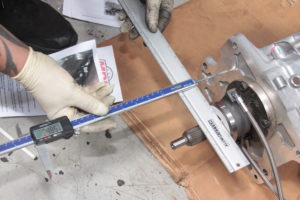
The hydraulic clutch release bearing is measured and adjusted, the Throw-out bearing just touching the fingers but not introducing any pre-load onto them
remember: It spins all the time.
The hydraulic throw-out bearings allow for constant contact of the throw-out bearing and is standard for hydraulic clutch actuation.
The hydraulic release bearing should be solid against the diaphragm, but not so much that it releases the clutch and there’s slippage.

The hydraulic clutch release bearing should be installed like this, with the bleeder line on top (where air bubbles rise) and the pressure line on the bottom.

The bellhousing has been installed. We’re ready for the Modern Driveline TKX.
Some installers install the bell and transmission as a single unit.
However, it is best to install the bell first, then, the transmission.

The TKX is stuffed into the bellhousing and seated. The release bearing is inspected for proper contact with the clutch diaphragm.
It is remarkable how well the TKX fits this Chevelle tunnel, and with plenty of room to spare.

Here’s a look at the installed TKX from the right-hand side.
Perfect fit from the completely redesigned TREMEC high-torque capacity TKX.

James’s Chevelle already had this G-Force crossmember, which fits the TKX perfectly.

Because the Chevelle didn’t have a factory cutout for a floor shifter, Miguel had to carefully measure and cut a provision for the floor shift.
Nice clean work and a perfect fit. The shifter fits smack in the middle of the hole Miguel cut.
Not sure why Chevrolet never had a provision in the tunnel for a floor shift.

The hydraulic lines for the hydraulic clutch are located here in the bell. The top line is for bleeding the clutch release cylinder.
The lower hose is for pressure from the clutch master cylinder.
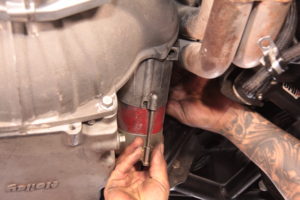
Miguel reinstalls the compact starter using the two vertical bolts involved.
It is so easy to install a GM starter because this was such a terrific approach.

The Chevelle’s driveshaft, which had been modified for the 4L60E transmission, was a perfect fit for our TKX when we changed the slip yoke.
If you’re swapping out a Turbo 350 or 400, or even the Muncie four-speed, you may have to build a new shaft.
Modern Driveline can help there too with a complete line of Dynotech steel, aluminum, and QA1 driveshafts (composite) custom-made to your order.
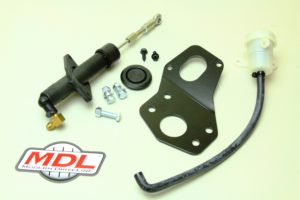
Modern Driveline offers a complete line of hydraulic clutch kits for virtually every application imaginable—and certainly GM A-bodies.
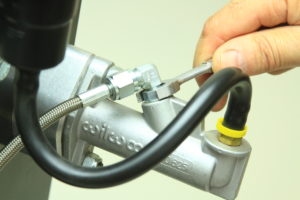
The Wilwood clutch master cylinder mounts at the firewall and is connected to the clutch pedal.
All you have to do is look to the pass-through for the mechanical clutch rod and use that as your master cylinder mount.
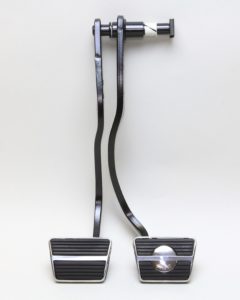
Modern Driveline is a one-stop shopping experience because they’ve thought of everything including clutch/brake pedal assemblies.
SOURCE:
Modern Driveline 208-453-9800 www.moderndriveline.com







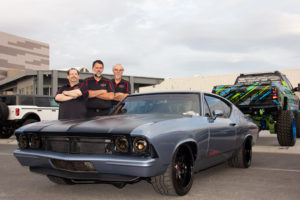




Please log in to leave a comment.
No Comments Yet